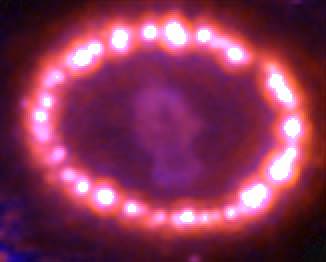[/caption]
The first supernova in 1987 (that’s what the “A” means) was the brightest supernova in several centuries (and the first observed since the invention of the telescope), the first (and so far only) one to be detected by its neutrino emissions, and the only one in the LMC (Large Magellanic Cloud) observed directly.
Ian Shelton, then a research assistant with the University of Toronto, working at the university’s Las Campanas station, and Oscar Duhalde, a telescope operator at Las Campanas Observatory, were the first to spot it, on the night of 23/24 February 1987 (around midnight actually); over the next 24 hours several others also independently discovered it.
The IAU’s CBAT went wild! That’s the International Astronomical Union’s Central Bureau for Astronomical Telegrams, the clearing house for astronomers for breaking news. You can read the historic IAUC (C for Circular) 4416 here.
Once the discovery of SN 1987A became known, physicists examined the records from various neutrino detectors … and found three, independent, clear signals of a burst of neutrinos several hours before visual discovery, just as predicted by astrophysical models! Champagne flowed.
Not long afterwards, the star which blew up so spectacularly – the progenitor – was identified as Sanduleak -69° 202a, a blue supergiant. This was not what was expected for a Type II supernova (the models said red supergiants), but an explanation was quickly found (Sanduleak -69° 202a had a lower-than-modelled oxygen abundance, affecting the transparency of its outer envelope).
The iconic Hubble Space Telescope image (above) of SN 1987A shows the inner ring, where the debris from the explosion is colliding with matter expelled from the progenitor about 20,000 years ago; more from the Hubble here.
AAVSO (American Association of Variable Star Observers) has a nice write-up of SN 1987A.
No wonder, then, that SN 1987A features so often in Universe Today stories; for example Supernova Shockwave Slams into Stellar Bubble, XMM-Newton’s View of Supernova 1987A, Supernova Left No Core Behind, and Hubble Sees a Ring of Pearls Around 1987 Supernova.
SN 1987A figures prominently in Astronomy Cast The Search for Neutrinos, and in Nebulae.
References:
AAVSO
University of Oregon

